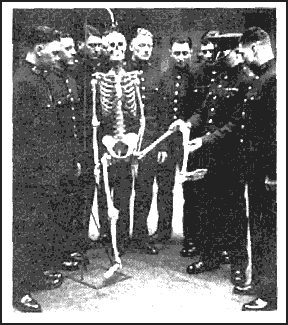Of Human Cadavers
Mary Roach
(Norton)

There are chapters on the black boxes from airplanes, what bullets do to bodies, and experiments with crucifixions. There's the stinky question of decay; there's a historical survey of medical dissection. There is a bit on head transplants, and, burp, the history and etiquette of eating defunct humans.
There are several ways to handle such a morbid subject but, thank god, our author has chosen to treat it with wit. On the subject, for instance, of the Chinese tradition of consuming afterbirth, she reports a few web-sites devoted to preparing it for consumption. for it is rumored "to relieve delirium, weakness, loss of willpower, and pinkeye."
The Virtual Birth Center tells us how to prepare Placenta Cocktail ... Placenta Lasagna, and Placenta Pizza. The latter suggests that someone other than Mom will be partaking --- that it's being cooked up for dinner, say, or the PTA potluck --- and one dearly hopes that the guests have been given a heads-up.
"The U. K.-based Mothers 35 Plus site lists 'several sumptuous recipes,' including roast placenta and dehydrated placenta."
Roach is not only a joker, she's also an intrepid, sometimes demanding, reporter. She goes to a hospital where organ transplants are done, visits the harvesting room. Patient H has been brain-dead for a few weeks and the doctors have permission to take the livers, kidneys, and heart. The author has a peek inside the chest cavity just before the heart is pulled, and reports,
I've never seen one beating, I had no idea they moved so much. You put your hand on your heart and you picture something pulsing slightly but basically still, like a hand on a desktop tapping Morse code. The thing is going wild in there. It's a mixing-machine part, a stoat squirming in it's burrow, an alien life form that's just won a Pontiac on The Price Is Right. If you were looking for the home of the human body's animating spirit, I could imagine believing it to be here, for the simple reason that it is the human body's most animated organ.
Roach's writing manages to hold an agile mix of reportage along with personal observation and beguiling amusement. She invites herself to a shooting range where different armaments are shot into "human tissue stimulant" to discover the effect --- e.g., a bullet's performance, the relevant destructibility of different gauge shots. Since live human thighs are hard to come by for such experimentation, the U. S. government is sponsoring experiments (at Oak Ridge, Tennessee) in this arcane field. The thigh of choice is an artificial one, made of "tweaked Knox dessert gelatin."
After watching the experiments, Roach --- being the inquisitive type --- calls Kind & Knox to find if they "included human tissue simulant on its list of technical gelatin applications." No response.
You would think that a company that felt comfortable extolling the virtues of Number 1 Pigskin Grease on its Web site ("It is a very clean material"; "Available in tanker trucks or railcars") would be okay with talking about ballistic gelatin..."
The author has a bit of a trouble cranking this one up, as if she isn't so sure herself where she wants to go. But once we dig in, we are not only given mountains of information on corpses, but, as well, on the body in general, and the strange and wonderful experiments being conducted on our behalf. Roach herself develops in the book: comes towards the end to reveal herself as a jolly, naughty, and sometimes perverse character in her own paean to the dead.
At the University of Tennessee Anthropological Research Facility, they have an area where they spread donated corpses out in the sun to observe the process of decay. As M. Lee Goff told us in his excellent book on forensics, A Fly for the Prosecution: How Insect Evidence Helps Solve Crimes, it is the key to medical forensics: exactly which stage a corpse has come to when discovered --- either through rot or through bug-munching --- will indicate the time of death.
Roach's pointed observations are, deliciously, if I may use that word, on the edge. Her guide, Arpad, explains that bacteria in the mouth and the genitalia make for considerable swelling. He says, "In the male, the penis and especially the testicles can become very large."
"Like how large?" (Forgive me.)
"I don't know. Large."
"Softball large? Watermelon large?"
"Okay, softball." Arpad Vass is a man with infinite reserves of patience, but we are scraping the bottom of the tank.
And, in China, she visits Hainan Province where, according to a scandalous newspaper article, one Hui Guang, who worked in a crematorium, "was caught hacking the buttocks and thighs off cadavers prior to incineration and bringing the meat to his brother who ran the nearby White Temple Restaurant." There they were served to the customers, buns on buns as it were.
Our writer, apparently, has neither shame nor couth. She and her translator visit the local crematorium, are introduced to the director, a woman "who was not smiling, had not smiled since she entered the room, had possibly never smiled..." The translator
relayed the story of Hui Guang, explained that I thought he might have been employed here, and that I wrote for a magazine and that I hoped to find him and speak to him. The director crossed her arms and her eyes narrowed. I thought I saw her nostrils flare. Her reply went on for ten minutes. Sandy nodded politely through it all, with the attentive calm of a person being given a fast-food order or directions to the mall. I was very impressed.
The director, needless to say, was "very ... astonished... feels it is a really sick story. And so she cannot help you." Mr. Roach comment: "I would love to see a full transcript of the director's reply, and then again I wouldn't."
This one is a killer. If you are dying for facts, they are all about:
- That the body is 73.8% water.
- That one doctor tried to weigh the soul by keeping those dying on a scale, claimed that at the moment of popping off, we lose 3/8 of an ounce.
- That one of the ecological damages of cremation is all that mercury in the teeth gets vaporized drifting off into the atmosphere.
- That if an airplane is going to crash, the best place to be is in first class.
- And the best thing to be is a young man: in crises, they always strong-arm everyone else out of the way to make it to the emergency exits.
- That the Mexican painter Diego Rivera and his friends "Pooled our money to purchase cadavers from the city morgue ... We lived on this cannibal diet for two months and everyone's health improved."
- That there is a company in Sweden named Promessa which is trying to convince the world that a "freeze-dry ecological funeral" is kinder to the earth than your standard burial or cremation.
- That in Sweden, the is no rest for the weary: after a few years, they bury another corpse on top of you.
- That in her considered opinion it behooves all of us to leave our bodies to medicine.
